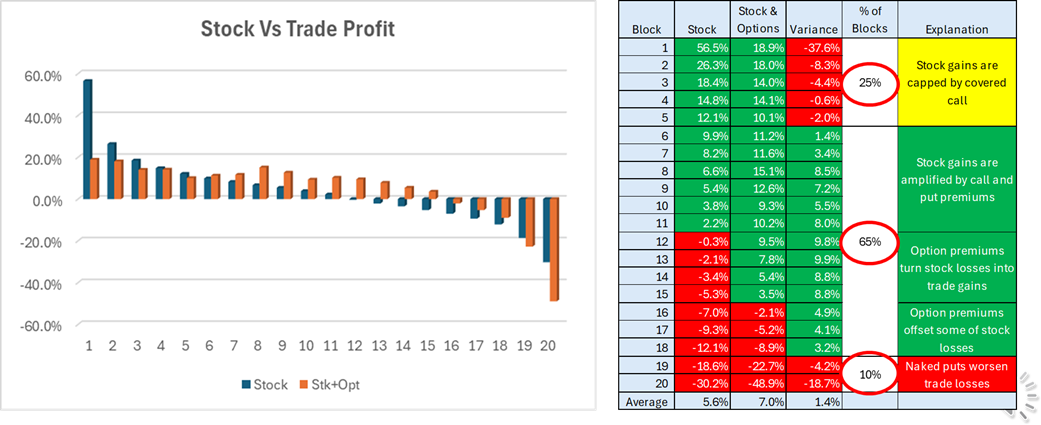Understanding Profit Probabilities - The Power of the Stock and Dual Option Selling Strategy

The Bull Strangle Newsletter, released weekly, shares a trading strategy that has achieved a documented 76% trade win rate and outperformed the S&P 500 by 240% since inception. The strategy combines buying stock and simultaneously selling out-of-the-money covered calls and cash-secured puts to generate option premiums and manage risk.
Overview
The Bull Strangle strategy is designed to generate consistent, repeatable income by combining stock ownership with the sale of both covered calls and cash-secured puts. Unlike traditional buy-and-hold investing, this approach changes the probability distribution of returns by continuously collecting option premiums. To understand how it performs across different market conditions, an analysis was conducted on 367 past trades, sorted from the highest to lowest stock gains. The results provide valuable insight into where profits — and risk mitigation — come from.

Breaking Down the Outcomes
The data shows that the Bull Strangle strategy creates a more balanced and resilient performance profile compared to simply owning the stock. Specifically:
- 25% of the time, the stock is profitable, but the total trade is less profitable because the covered call caps the upside. This illustrates the trade-off inherent in the strategy: some gains are sacrificed in exchange for steady income.
- 30% of the time, the stock is profitable, and the total trade is even more profitable because option premiums enhance the returns. In these cases, the income from selling options adds a meaningful boost.
- 20% of the time, the stock itself is not profitable, but the trade still ends up profitable because the option premiums offset the stock losses. This is one of the key advantages of the Bull Strangle — turning what would have been losing trades into winners.
- 15% of the time, the stock is not profitable, but the losses are reduced thanks to the option premiums. While not enough to swing the trade into positive territory, the strategy still cushions the downside.
- 10% of the time, the stock is not profitable, and the trade performs even worse because the short put adds to the losses. This is the least favorable outcome, but it occurs only a fraction of the time.
What the Numbers Tell Us
When viewed together, these probabilities show why the Bull Strangle is effective:
- In 50% of cases, the options improve profitability (30% boosting gains, 20% converting losers to winners).
- In 15% of cases, they reduce losses compared to stock-only exposure.
- Only in 10% of cases do options make the outcome worse.
This probability profile demonstrates the strategy’s edge: while covered calls sometimes cap stock gains, the trade-off is a significant improvement in consistency, reduced volatility in returns, and a greater likelihood of positive outcomes over time.
Conclusion
The Bull Strangle is not designed to maximize profits in runaway bull markets — it is built to grind out steady, risk-controlled returns across a wide range of market conditions. The historical data makes this clear: by systematically selling option premium, traders shift the odds in their favor, turning many losing scenarios into break-evens or winners. Over hundreds of trades, this consistency compounds, making the Bull Strangle a strategy that favors discipline, patience, and probability over speculation.
More Information
For a short video explaining the Bull Strangle strategy.
For a more detail on the strategy
To subscribe to the Bull Strangle Newsletter
Contact
Darren Carlat
Managing Director
Darren@SpreadEdgeCapital.com
(214) 636-3133
Disclaimer
This information is for informational purposes only and should not be considered as investment advice. Past performance is not indicative of future results, and all investments carry inherent risk. Consult with a financial advisor before making any investment decisions.